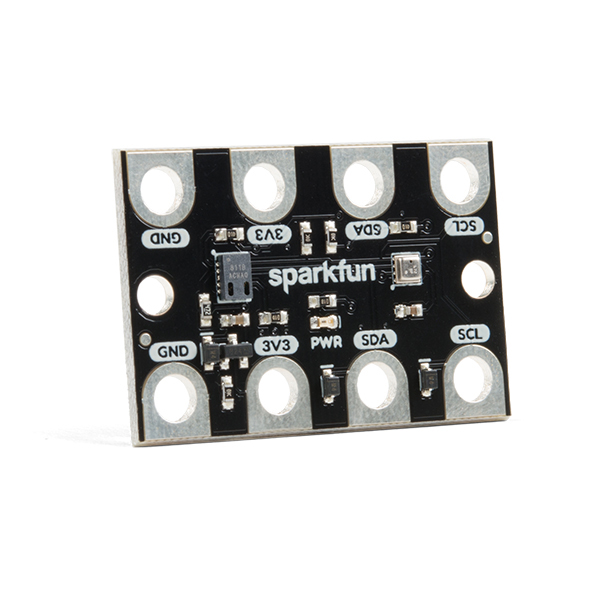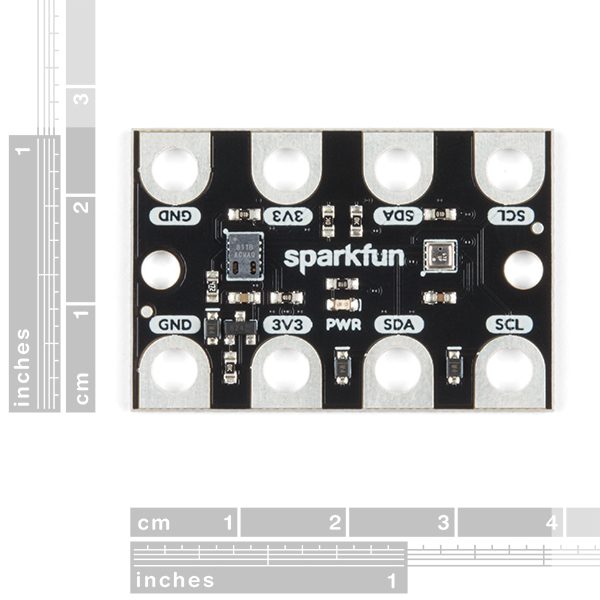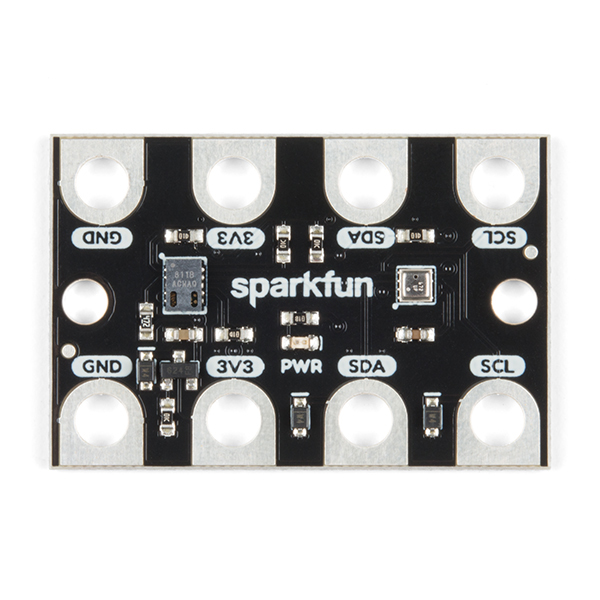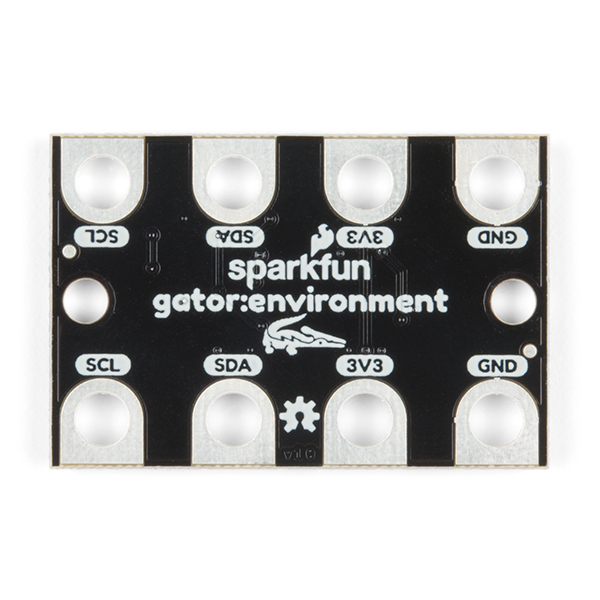SparkFun gator:environment - micro:bit Accessory Board
The SparkFun gator:environment micro:bit Accessory Board utilizes the popular CCS811 and BME280 ICs to take care of all of your environmental readings of atmospheric quality. This sensor board can provide a variety of environmental data, including barometric pressure, humidity, temperature, equivalent TVOCs and equivalent CO2 (or eCO2) levels. The gator:environment connects to the SparkFun gator:bit via alligator-clip cables, allowing for easy access to the micro:bit's I2C pins.
The CCS811 is a digital metal oxide (MOX) gas sensor that detects wide range of Volatile Organic Compounds (VOCs). With an integrated microcontroller that implements special algorithms to process the raw measurements, the CCS811 outputs the equivalent total VOC (eTVOC) and equivalent CO2 (eCO2) values over an I2C connection. It provides readings for the total volatile organic compounds in the parts per billion (PPB) and equivalent CO2 (or eCO2) in the parts per million (PPM). It also has a feature that allows it to fine tune its readings if it has access to the current humidity and temperature. Luckily for us, the BME280 provides humidity, temperature, and barometric pressure! This allows the sensors to work together to give us more accurate readings than they'd be able to provide on their own.
Note: Unfortunately, CO2 isn't a VOC and MOX type of sensors can't directly measure CO2, despite being great at VOC detection. However, in an indoor setting, humans are a primary source of VOCs through the process of breathing. The equivalent CO2 (eCO2) values are then estimated based on algorithms that are used to analyze the sensor data to determine the TVOC attributed by the presence of humans. This type of sensor should not be used in applications that directly require the measurement of CO2; it is an inferred value.
The micro:bit is a pocket-sized computer that lets you get creative with digital technology. Between the micro:bit and our shield-like bit boards you can do almost anything while coding, customizing and controlling your micro:bit from almost anywhere! You can use your micro:bit for all sorts of unique creations, from robots to musical instruments and more. At half the size of a credit card, this versatile board has vast potential!
- gator:bit Compatible
- CCS811
- Operating Voltage: 1.8V-3.6V
- Supply Current: 30 mA (average)
- Equivalent Total VOCs (eTVOC): 0-32768 ppb
- Equivalent CO2 (eCO2): 400-29206 ppm
- I2C Address: 0x5B (HEX)
- BME280
- Operating Voltage: 1.71V-3.6V
- Supply Current: < 714 µA
- Humidity Range: 0 to 100% RH
- Temperature Range: -40°C to 85°C
- Pressure Range: 300 to 1100 hPa
- I2C Address: 0x77 (HEX)
- Schematic
- Eagle Files
- Hookup Guide
- Datasheet (BME280)
- Datasheet (CCS811)
- Design Guide (CCS811)
- Factsheet (CCS811)
- gator:environment PXT Package
- micro:bit Information Page
- GitHub Hardware Repo
SparkFun gator:environment - micro:bit Accessory Board Product Help and Resources
SparkFun gator:environment Hookup Guide
June 13, 2019
The gator:environment combines two I2C sensors for temperature, humidity, pressure, eCO2, and eTVOC values. This tutorial will get you started using the gator:environment with the micro:bit platform.
SparkFun gator:bit v2 Hookup Guide
January 31, 2019
The gator:bit v2 is a breakout board for the BBC micro:bit. The gator:bit exposes almost every pin on the micro:bit to clippable pad with circuit protection. It also has as built-in addressable LEDs and a built-in buzzer.
Getting Started with the micro:bit
September 2, 2021
The BBC micro:bit is a compact, powerful programming tool that requires no software installation. Read on to learn how to use it YOUR way!
Core Skill: Programming
If a board needs code or communicates somehow, you're going to need to know how to program or interface with it. The programming skill is all about communication and code.
Skill Level: Rookie - You will need a better fundamental understand of what code is, and how it works. You will be using beginner-level software and development tools like Arduino. You will be dealing directly with code, but numerous examples and libraries are available. Sensors or shields will communicate with serial or TTL.
See all skill levels
Core Skill: Electrical Prototyping
If it requires power, you need to know how much, what all the pins do, and how to hook it up. You may need to reference datasheets, schematics, and know the ins and outs of electronics.
Skill Level: Rookie - You may be required to know a bit more about the component, such as orientation, or how to hook it up, in addition to power requirements. You will need to understand polarized components.
See all skill levels
Comments
Looking for answers to technical questions?
We welcome your comments and suggestions below. However, if you are looking for solutions to technical questions please see our Technical Assistance page.
Customer Reviews
No reviews yet.




